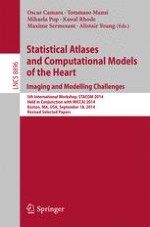2015 | OriginalPaper | Buchkapitel
Structural Abnormality Detection of ARVC Patients via Localised Distance-to-Average Mapping
verfasst von : Kristin McLeod, Marcus Noack, Jørg Saberniak, Kristina Haugaa
Erschienen in: Statistical Atlases and Computational Models of the Heart - Imaging and Modelling Challenges
Aktivieren Sie unsere intelligente Suche, um passende Fachinhalte oder Patente zu finden.
Wählen Sie Textabschnitte aus um mit Künstlicher Intelligenz passenden Patente zu finden. powered by
Markieren Sie Textabschnitte, um KI-gestützt weitere passende Inhalte zu finden. powered by
Many heart conditions result in irregular ventricular shape caused by, for example, increased ventricular pressure, regurgitated blood and poor electrical conduction, which affect the overall function of the heart. Structural abnormalities can be characteristic of a disease. Therefore, identifying structurally abnormal regions can give indicators for diagnosis and can provide useful information to guide long-term therapy planning. Given the difficulty in quantitatively measuring structural abnormalities in patients where the ventricular structure is significantly affected by the pathology, such as patients with arrhythmogenic right ventricular cardiomyopathy (ARVC), a method for computing the distance between a normal geometry and patient-specific geometries is presented. The proposed method involves computing distance maps that can visually emphasise regions with high variation from a normal geometry. A consistent parameterisation of the ventricular shape is imposed using an open-source implementation of the LDDMM algorithm on currents to deform patient-specific geometries to a mean surface, which is also computed using the LDDMM algorithm. The chosen shape parameterisation can be applied to meshes extracted from any segmentation algorithm, allowing a wide range of data to be analysed from different hospitals, different scanners and different imaging modalities. Given a consistent shape parameterisation of all meshes, distance maps can be generated by plotting the Euclidean distance point-wise on a triangulated mesh to visualise regions of high shape variability. The proposed method was applied to 10 ARVC patients to highlight patient-specific shape features.
